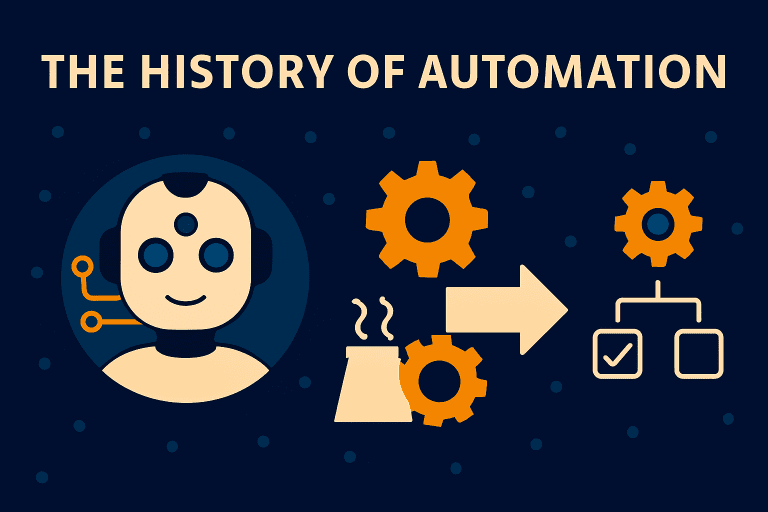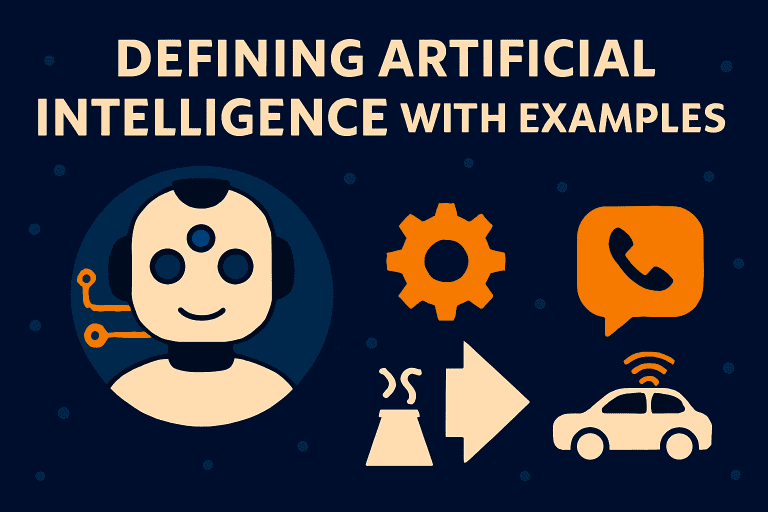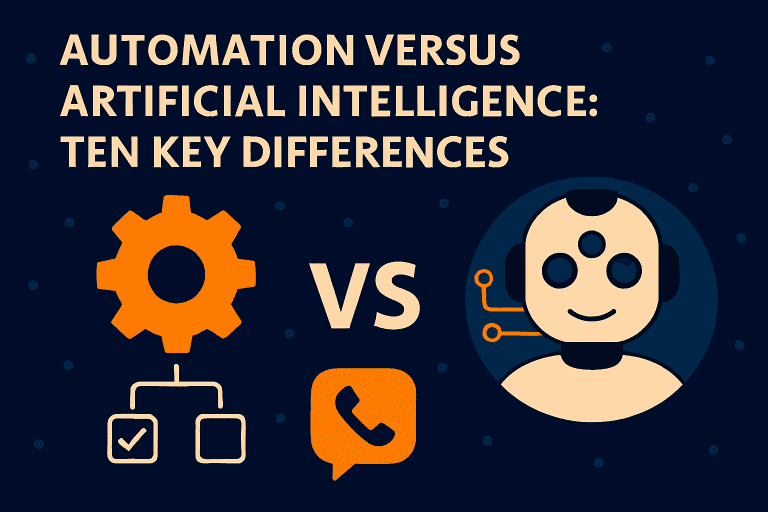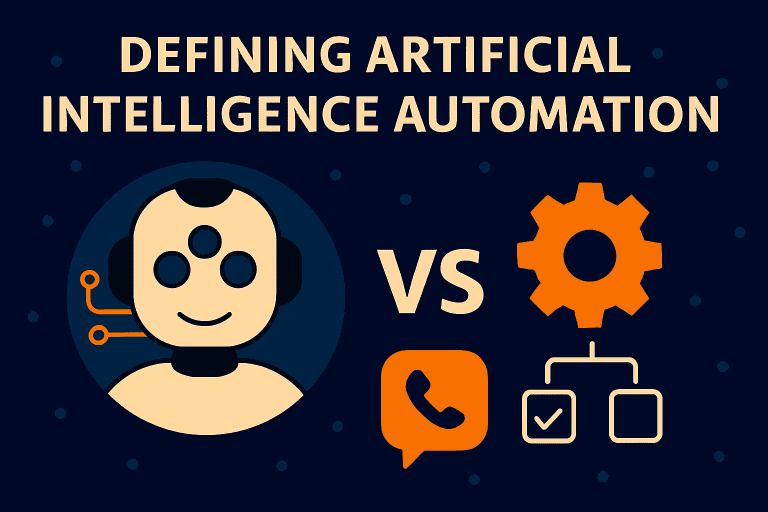What is AI Automation? All there is To Know

The last three decades have seen terms such as robotics, automation, and artificial intelligence gain increasing popularity. Differentiating between the three terms is becoming a challenge for most people. This comprehensive article defines AI automation, provides its history, differentiates AI from automation, offers examples of AI automation, and outlines the benefits and challenges of AI automation. Moreover, the article shall encapsulate the future of AI automation, the basic models of AI, and shed light on how to implement AI automation in business processes.
Defining Automation: What is Automation?
Automation refers to the operation of work processes, procedures, and equipment that do not require human intervention. The term does not correspond with the translation of human functions but refers to the reorganisation of processes in ways that specify human and machine interactions. Automation processes encompass mechanical, electronic, and computer-based systems that enable machine operations with minimal or reduced human intervention. Such methods would allow humans to achieve superior performance compared to manual labour. Some examples of automation include the movement of automatic machine parts, such as industrial conveyor belts or lathe machines, as well as assembly machines, industrial tools, and material handling equipment.
The History of Automation

Humanity has sought to mitigate the effects of manual labour since the earliest stages of human civilisation. As such, people invented the wheel between 3500 and 3350 BC to eliminate the strenuous task of walking or moving goods, animals, farm produce, or people. These efforts, characterised by early humans’ inventions such as tools, equipment, housing, and many more, have accumulated over time, leading to modern-day automation.
Modern-day automation, characterised by mechanical, electronic, and computer processes, originated during the early civilisations of Egypt and Greece, where they developed simple operating machines that implemented basic instructions. Some examples of these forms of automation include automated looms and player pianos, which played music as set on paper piano rolls. Such conceptions evolved into industrial revolution inventions, which saw humanity seeking innovative methods to reduce the labour required to convey products and services. The automatic machining systems invented during the industrial revolution have since reduced production costs and improved product quality.
The term ‘automation’ as utilised in the modern-day context emanated from the Ford Motor Company in the 1940s by D. S. Harder. The automotive industry had a keen interest in replacing human labour with mechanised systems to increase production and provide better quality of goods and services. Other advantages sought through mechanisation included reducing human health risks and time wastage. Other instances of automation followed, including their implementation in the military through the disposal of bombs. Inventions such as these were compounded into computer systems and later into artificial intelligence.
Computer systems paved the way for the adoption of automation through numerical control, computer-aided manufacturing, flexible manufacturing systems, and industrial robots. These computer systems paved the way for digital computers, along with data storage technologies that enabled the storage of files, program commands, and software for programming. The advancement of electronic digital computers allowed humanity to control functions such as fast calculations, which characterised the digital revolution. The digital revolution was driven by discoveries such as magnetic memory, microprocessors, and battery technologies, which enabled further advancements in computer systems and ultimately paved the way for the information age.
Artificial intelligence arose from the need to automate tasks. It emerged through concepts such as machine learning, which enable the extraction, interpretation, and predictive analysis of data. Humanity can invent virtual assistants, chatbots, prompts, scripts, and so much more.
Defining Artificial Intelligence with Examples

Artificial intelligence refers to advanced computer systems or technologies that enable computers to execute complex tasks traditionally performed by humans, such as reasoning, decision-making, learning, imagination, perception, language processing, translation, teaching, and self-sufficiency. This field, therefore, enables people to construct computer systems that are capable of reasoning, learning, and acting in ways that necessitate human intelligence.
Some of the most popular examples of artificial intelligence include maps and navigation, facial recognition and detection, auto-correction in written text, search engine optimisation, chatbots, digital assistants, social media, online payments, weather forecasting, and many more.
Automation versus Artificial Intelligence: Ten Key Differences

Automation and artificial intelligence share resemblances that have led to their interchangeable use. Their differences lie in their problem-solving abilities and their performance in tasks. The section below highlights their differences.
| Area of Difference between AI and Automation | Artificial Intelligence | Automation |
| Purpose | They emulate human qualities such as learning, imagination, creativity, decision-making, writing, and designing, among others. | Helps humans perform repetitive tasks with precision to improve the quality of output |
| Decision-making Abilities | Executes decisions following available data or patterns | Executes predefined rules. For example, mechanical or electromechanical movements |
| Learning | Their performance improves with time and with access to data | Their performance remains constant over time unless someone introduces new performance criteria, steps, scripts, patterns, or mechanical or electronic components. They are primarily rule-based |
| Flexibility | They are very flexible and can perform well in different contexts | They are inflexible and can handle only specific tasks at a time |
| Complexity | They handle highly complex domains, such as design, content creation, prediction, and many more. | They provide structured and simple processes |
| Problem-solving Abilities | They can solve a wide array of problems if presented with data | They solve specific problems in fixed ways |
| Ability for Interactions with Humans | They allow for human interactions, enabling their systems to engage in conversations and behaviour. | Humans interact with automation systems through labour or behind the scenes. |
| Technologies Implemented | Their systems utilise neural networks, big data, large language models, and algorithms. | They work with predefined scripts and robotic process automations |
| Evolution | Their performance improves with access to data and training | Their performance does not change unless provided with improved scripts or through the introduction of new components |
| Applications Developed | They avail chatbots, agents, search engines, social media, and so much more. | They provide data entry capabilities, reports, and system backups. |
The differences captured above encapsulate AI Automation as described below.
Defining Artificial Intelligence Automation (AI Automation)

AI automation emerges from the integration of all the information above. It refers to the use of artificial intelligence in automation to empower humans to handle repetitive tasks without human involvement. The domain of AI automation utilises concepts such as machine learning, natural language processing, and predictive analytics to create superior systems compared to automation.
The sections above determined that automation utilises robotic processing to do tasks. Additionally, automation evolved into intelligent automation and was eventually synthesised with artificial intelligence and business process management. AI automation confers numerous benefits, including reduced inefficiencies, error elimination, and enhanced decision-making capabilities. These systems can predict errors before they take place and individualise customer experiences.
Are you Looking for AI Automation Services?
Join 1000+ Satisfied Clients by Contacting us below
